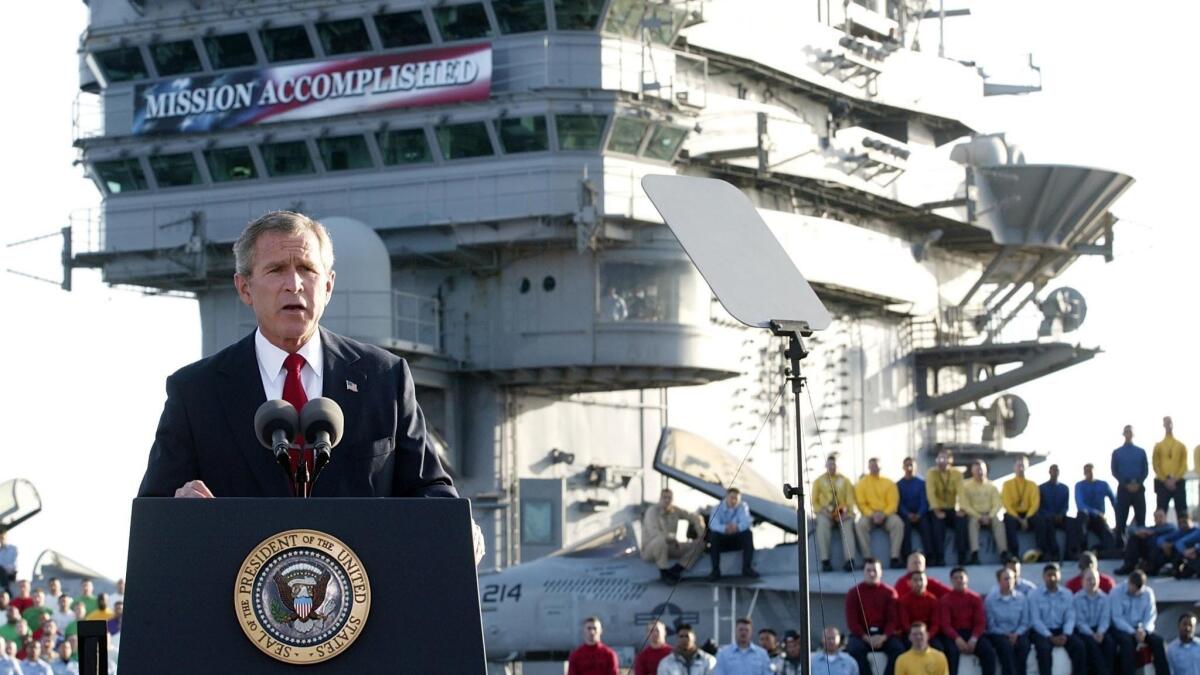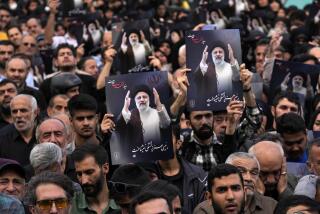Commentary: When it comes to Iran, Trump wants it to be 2003. In media terms, that’s eons ago
- Share via
The footage was familiar: Throngs of jubilant young men poured into the streets of Baghdad, waving flags and celebrating their newfound freedom, thanks to the liberating efforts of the United States.
“Iraqis — Iraqis — dancing in the street for freedom; thankful that General Soleimani is no more,” wrote Secretary of State Mike Pompeo on Twitter, posting the video shortly after a strike ordered by President Trump killed Iran’s top military leader Friday in Baghdad.
2020 was just a few days old, but it already felt a lot like 2003.
A first-term president with negative approval ratings ordered military action in Baghdad. Intelligence used to justify the action was questioned. The media pivoted away from considerable domestic woes to cover the new conflict.
Broadcasts front-loaded primers on Sunni vs. Shiite relations, pushing impeachment segments to the back of the hour. Former hot spots like the Green Zone and the Baghdad airport became newsworthy again. Welcome back, Fareed Zakaria and Richard Engel.
We’ve been here before. But when it comes to making the case for a new military campaign in the region, the Trump administration appears to be using a hoary old playbook. And it no longer applies.
Despite social media and the press lighting up with comparisons to the lead-up to the war in Iraq — framed, in the parlance of the modern internet, as listicles — the White House’s attempt to sell conflict with Iran enters a vastly different landscape.
Since then, traditional media has fragmented into smaller and smaller niches, and platforms such as Twitter and Facebook have become the front lines of breaking news — and, of course, misinformation.
Now the reality TV showman who used new media to bypass conventional campaign channels, rally a fan base and win the White House must confront those very same factors in a complicated world theater, and this time, they may turn against him.
Trump’s promise, following Suleimani’s killing, that “The future belongs to the people of Iran,” sounded like it was pulled from the same re-election pamphlet used by George W. Bush, rather than the lexicon of a “tell it like it is” iconoclast who tweeted his way to the Oval Office. And the message barely had time to land before Iran’s supreme leader began trending.
Video and reports of Ali Khamenei vowing “severe revenge” emerged, as did footage of angry crowds flooding into Tehran’s streets. They were not thanking America for liberating them; they were cursing it. The immediacy of the response, which extended to Iran firing missiles at U.S bases in Iraq late Tuesday — also signaled that this wasn’t going to be like the last time we engaged in war in the region.
The opposition is getting equal time on platforms that didn’t even exist when operation “shock and awe” rolled into Baghdad. Today the Arab and Iranian street can broadcast its own story via WhatsApp, YouTube, Instagram or dozens more conduits that give voice to the traditionally voiceless, using the same direct methods of communication as the all-powerful leader of the free world.

As for traditional news outlets, a pliable media helped the Bush administration build its case against Saddam Hussein, parroting claims that the dictator had ties to the 9/11 attacks and possessed an arsenal of “weapons of mass destruction.” Neither turned out to be true.
Rumor is there’s a strained relationship between the current White House and the press corps. Perhaps Suleimani did pose an “imminent threat,” but reporters who’ve been locked in a mutual cycle of distrust with Trump since 2016 aren’t going to just take his word for it.
Justifying a potential war with Iran is a hard sell, even for Fox News.
Even staunch Trump defender Tucker Carlson voiced doubt about the motives of the attack. “Nobody mourns his passing … but Mexico and China are also linked to the deaths of Americans,” he said Friday. “Each has flooded our country with narcotics from which tens of thousands of Americans die every single year … So does that mean we get to bomb Oaxaca? Can we start assassinating generals in the [Chinese] People’s Liberation Army?”
Rules of engagement require actual rules, and those are in short order around Washington these days. Bets are there’s no strategy behind the terrifying escalation with Iran, other than the goal to distract folks long enough to forget about that “witch hunt.”
Making the rounds on the Sunday shows, Pompeo defended Suleimani’s killing, while Trump supporters Chris Christie — suggesting that Iran responds only to force — and Lindsey Graham — calling Iran “the cancer of the Middle East” — added to the chorus, but they seemed to be singing the same tune once associated with Colin Powell and Condoleezza Rice in the days of the “axis of evil.”
But 2020 is not 2003, a fact to which Pompeo may be wising up. He recently employed the more tried-and-true method of blaming President Obama for the current tensions with the Islamic Republic. Whether that tactic finds more purchase than the administration’s current (wag the) dog-and-pony show remains to be seen. But at least traveling back to 2008 means we can tweet about it.
More to Read
The complete guide to home viewing
Get Screen Gab for everything about the TV shows and streaming movies everyone’s talking about.
You may occasionally receive promotional content from the Los Angeles Times.







